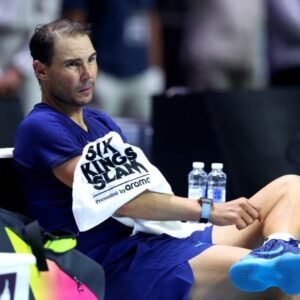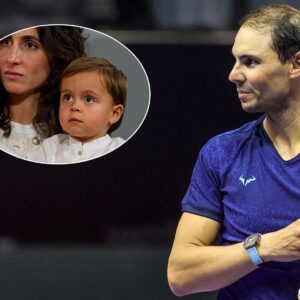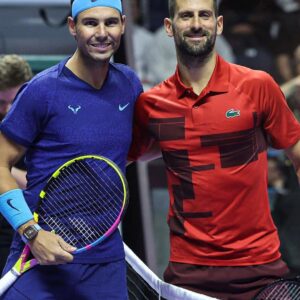There was a glint in the eye of Rafael Nadal as he stood waiting patiently to meet his Real Madrid heroes back in 2003. As a self-proclaimed Madridista, this was an opportunity not to be missed.
Taking some time away from his schedule at the Madrid Masters, there was a sense of excitement in the 18-year-old Nadal as he stood holding the famous white jersey, waiting for it to be emblazoned with signatures.
One by one they came towards him; Raul, David Beckham, Roberto Carlos, Luis Figo, Ronaldo, Zinedine Zidane. Superstars who defined the era of the Galacticos at Real Madrid.
Now, 21 years down the line, it is Nadal who walks off into the sunset as a bona fide Galactico of the tennis world, a key part of a quartet who shaped the greatest era in the history of the game.
Rafa, Roger, Novak, Andy; four players who, between them, smashed every record in the book and pushed each other to new heights during a truly golden age for men’s tennis.
Only Djokovic remains. Given his remarkable powers of endurance, it remains eminently possible that the 37-year-old Serb could further extend his record of 24 Grand Slam titles.

A young Rafa Nadal has his Real Madrid shirt signed by Spanish football legend Raul

Nadal and Federer embrace at the end of the incredible 2008 Wimbledon final

Nadal with the Wimbledon trophy in 2008 after his five-set victory over Federer
But it is the retirement of 38-year-old Nadal, with 22 Grand Slam crowns of his own, that has prompted such an outpouring of love and appreciation for one of the game’s all-time greats.
Given his total domination of the French Open for the best part of 20 years, it is only natural that many will view Nadal’s career through the prism of Roland Garros.
The undisputed King of Clay won 14 of his Grand Slams in Paris, a run which started in 2005 and finished in 2022.
All in all, Nadal’s record in matches at Roland Garros reads as 112-4. That’s 112 victories and only four defeats. Rarely can one athlete have dominated one event for such a prolonged length of time.
Nadal’s mastery of the clay courts led to the French Open trophy becoming his own personal property. With his distinctive ‘nibble’ celebration, where he would playfully try to bite the trophy, he won it so many times that he could probably have eaten it three times over.
But, for British tennis fans, the most cherished memories of Nadal are more likely to be associated with a summer’s night back in 2008, when his brilliance illuminated the fading light on Centre Court at Wimbledon.
He beat Roger Federer in a truly epic final. Nadal took the first two sets, only for Federer to come roaring back and force it into a decider.
Nadal would eventually triumph to win it in five sets, with the match lasting four hours and 48 minutes. It was widely regarded as the greatest match ever played. Not only at Wimbledon, but in the history of the sport.
Commentating live on the BBC, John McEnroe declared: ‘The greatest match I’ve ever seen.’
Watching from the Royal Box, Bjorn Borg said: ‘That’s the best tennis match I’ve ever seen in my life. I was just happy to be there, to be part of that final. You cannot see a better tennis match.’
It ended a run which had seen Federer win five men’s singles titles in succession at SW19. As the light dimmed and the cameras flashed around him, Nadal clambered up into the stand to celebrate with his family and coaching staff.

Nadal defeated Scotland’s Andy Murray on his way to the 2008 Wimbledon final
Soon, he was in the Royal Box. Marauding around Centre Court, he was a young matador from Mallorca whose power and aggression would thrill the crowds at Wimbledon for a generation.
There was a mutual respect and friendship between Nadal and Federer that would shape their rivalry. In a charity match back in 2010, Federer asked: ‘Do you know what you’re getting me for Christmas yet, Rafa?’
The crowd burst into laughter and it typified the relationship between these two giants of the game. They were the best of enemies in their pursuit of Grand Slam titles, but also the best of friends in lighter moments.
The issue of popularity among fans is something which Djokovic has always struggled with, but not so in the case of the other three members of The Big Four of men’s tennis.
With Federer, you couldn’t help but marvel at the sheer elegance and artistry of a man who simply glided his way around the tennis court.
With Murray, you were guaranteed to go through a rollercoaster of emotions. He would take you on a wild ride where no match was ever lost until his opponent had won the final point.
To see Nadal in his pomp was to witness the perfect marriage of sublime technique and raw physical power. His forehand, often delivered with freakish levels of spin on the ball, was at times unplayable.
There was also a charm and likeability with Nadal. With his bulging biceps, tanned complexion and good looks, every man wanted to be like him and every woman wanted to be with him. A housewives’ favourite, if you will.
Nadal departs as one of the game’s all-time greats and Murray fans will doubtless wonder how many more Grand Slams their man might have won had it not been for Rafa, Novak and Roger.
Murray never actually faced Nadal in a Grand Slam Final. Most of his pain was inflicted by Djokovic and Federer, who between them accounted for all eight of Murray’s defeats in major finals.
It was Djokovic who was on the other side of the net when Murray finally won his first two Grand Slams at the US Open in 2012 and Wimbledon in 2013, before he added a third against Milos Raonic in 2016.
By that point, Nadal had already predicted two years previously that the Golden Age for the Big Four may soon be coming to an end.
At the French Open in 2014, he said: ‘I think that our generation is now on the way out. We have been here for a long while. A generation is walking away and others will replace us. It will not come overnight, but it will come.’

The Big Four… Nadal, Murray, Federer and – last-man standing – Novak Djokovic
He was, thankfully, wildly premature with that assessment. Nadal has played on until 38, despite these past two years being wrecked by injuries.
Federer was still playing at Wimbledon just a month shy of his 40th birthday. Murray battled on until he was 37, before injuries finally forced him to call it a day at 37.
Whilst Murray never faced Nadal in a Grand Slam Final, the Spaniard still broke the hearts of British tennis fans at several junctures when he game’s biggest prizes were up for grabs.
Nadal beat Murray in the quarter-finals at Wimbledon back in 2008 en route to that epic triumph over Federer.
He would also triumph over the Scot on two more occasions at SW19, knocking Murray out in the semi-finals in successive years in 2010 and 2011.
He would spend a total of 209 weeks at World No 1 across a glittering career. Now that the curtain has come down, a true legend of the game will prepare for his final act at the Davis Cup Finals next month.
He leaves the game with no challenge unconquered. A tennis Galactico whose sublime talents helped re-define his sport. As far as legacy goes, that’s not bad. Vamos, Rafa.





